 I continued 'Geothermal Day' with a drive north. I should explain - everything is relative when driving in New Zealand. It's like one giant volcano: all twists and turns an up and down. A Kiwi told me, "A kilometer is longer here than in other places," and it is very true. Plus, the maps lie. They say a road makes an 'S' when it's more like the outline of a fern leaf.
I continued 'Geothermal Day' with a drive north. I should explain - everything is relative when driving in New Zealand. It's like one giant volcano: all twists and turns an up and down. A Kiwi told me, "A kilometer is longer here than in other places," and it is very true. Plus, the maps lie. They say a road makes an 'S' when it's more like the outline of a fern leaf.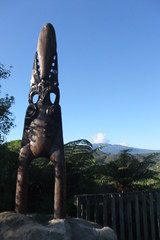 They are very proud that Waimangu is (one of) the world's youngest geothermal areas, due to a major eruption in 1886, and a smaller one in 1917, making it an infant in geological time. The signs are filled with photos of doomed vacationing Victorians, and Edwardians who should have known better. (Remember kids, volcanoes are not toys). It's quite magical, lush and wild. It looks like the Lost World, or like one has suddenly been transported to the Cretaceous, what with all the fern trees and steaming lakes. Also, generally, there is a lack of mammals (other than people, and a couple of feral cats I met). A particularity of New Zealand is that all mammals were introduced by people. The rats, of course, arrived first with the Maori, about 800 to 1000 years ago. Successive migrations brought pigs, dogs, and of course, cattle and sheep. Then some now cursed people brought the Australian possum (a vegetation eating machine, rapidly destroying the native plants and hence killing the native birds), which Kiwis try to hit with cars for sport. Anyway, this creates a landscape full of vegetation and sounds from another era.
They are very proud that Waimangu is (one of) the world's youngest geothermal areas, due to a major eruption in 1886, and a smaller one in 1917, making it an infant in geological time. The signs are filled with photos of doomed vacationing Victorians, and Edwardians who should have known better. (Remember kids, volcanoes are not toys). It's quite magical, lush and wild. It looks like the Lost World, or like one has suddenly been transported to the Cretaceous, what with all the fern trees and steaming lakes. Also, generally, there is a lack of mammals (other than people, and a couple of feral cats I met). A particularity of New Zealand is that all mammals were introduced by people. The rats, of course, arrived first with the Maori, about 800 to 1000 years ago. Successive migrations brought pigs, dogs, and of course, cattle and sheep. Then some now cursed people brought the Australian possum (a vegetation eating machine, rapidly destroying the native plants and hence killing the native birds), which Kiwis try to hit with cars for sport. Anyway, this creates a landscape full of vegetation and sounds from another era.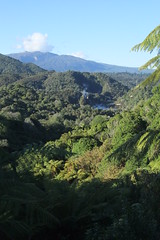
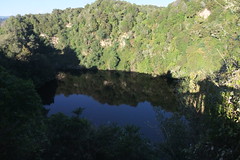
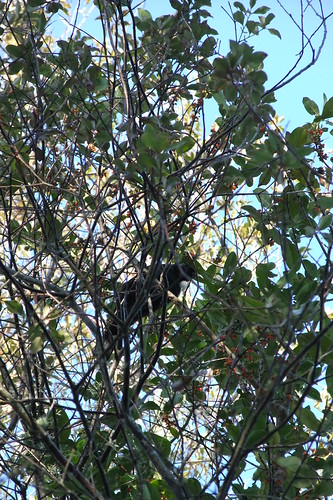
This is a tui bird with a white tuft under his chin. He is a symbol of New Zealand. They named a beer after him. He is a noisy bird, but fast.

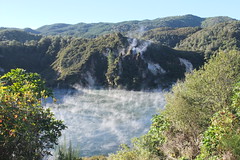


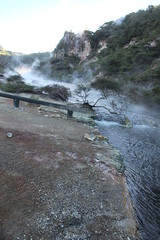
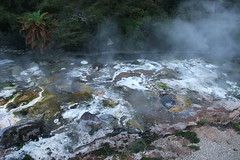
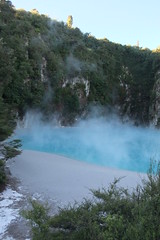
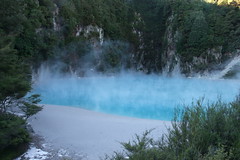
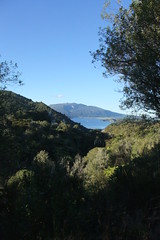
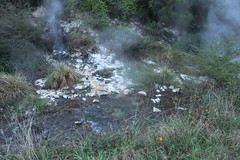
 I didn't make it in time to take the ferry ride along the lake to see the caldera appear from behind the steam (which Grant said made a huge impression on him as a boy - it must be easy to make future-earth scientists with school field trips in this country), but I did take the longer hike. They should really post some signs though stating the grade as well as the height. It's all well and good for me to think this hill is only one-fifth of the height of the one on Kapiti, if no one tells me, yes, put this one is straight up a muddy hill. I probably would still have hiked it, but I might at least have known what I was in for. The other hikers were a young red-faced (from hiking) English couple and a young red-faced (from hiking) Irish couple, based on accent.
I didn't make it in time to take the ferry ride along the lake to see the caldera appear from behind the steam (which Grant said made a huge impression on him as a boy - it must be easy to make future-earth scientists with school field trips in this country), but I did take the longer hike. They should really post some signs though stating the grade as well as the height. It's all well and good for me to think this hill is only one-fifth of the height of the one on Kapiti, if no one tells me, yes, put this one is straight up a muddy hill. I probably would still have hiked it, but I might at least have known what I was in for. The other hikers were a young red-faced (from hiking) English couple and a young red-faced (from hiking) Irish couple, based on accent.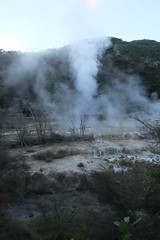
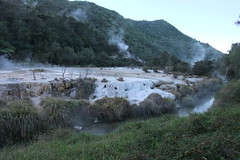
The English and Irish people waited for the bus back at the penultimate stop but I continued to the lake, hoping to make it there before the last bus.
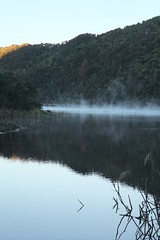

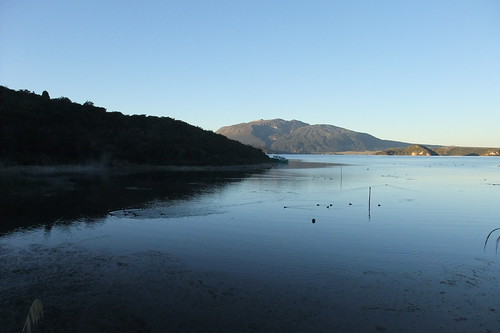
 I was the only one waiting for the bus, so the driver, the ferry driver and other park workers peppered me with questions; where was I from, what had I seen, how long was I in New Zealand, what did I do. One of the old guys teased the other about not being able to identify my accent. Everywhere I went in New Zealand, people mistook me for American and then apologized, which I confess amused me greatly. They hate being mistaken for Australians. When they heard I was a geophysicist they decided I was a volcanologist and asked if I had been to see the institute in Wairaki (yes) and if I was next off to see Iceland (no, unless someone wants to send me there ;).
I was the only one waiting for the bus, so the driver, the ferry driver and other park workers peppered me with questions; where was I from, what had I seen, how long was I in New Zealand, what did I do. One of the old guys teased the other about not being able to identify my accent. Everywhere I went in New Zealand, people mistook me for American and then apologized, which I confess amused me greatly. They hate being mistaken for Australians. When they heard I was a geophysicist they decided I was a volcanologist and asked if I had been to see the institute in Wairaki (yes) and if I was next off to see Iceland (no, unless someone wants to send me there ;). Often, they would tell me surprising things, like, "Oh yes, I've been near Toronto. My brother lived in Prince Albert, Saskatchewan." Clearly these people (the Pakeha, the Kiwis of European (usually British) decent, have genes like my ancestors which said, 'Go somewhere remote!' The Scottish comic Billy Connelly has a great routine about Scots pioneers arriving in Georgia and finding the weather too pleasant, declaring, 'Go North to Hudson's Bay, where it is barren and freezing!'









No comments:
Post a Comment